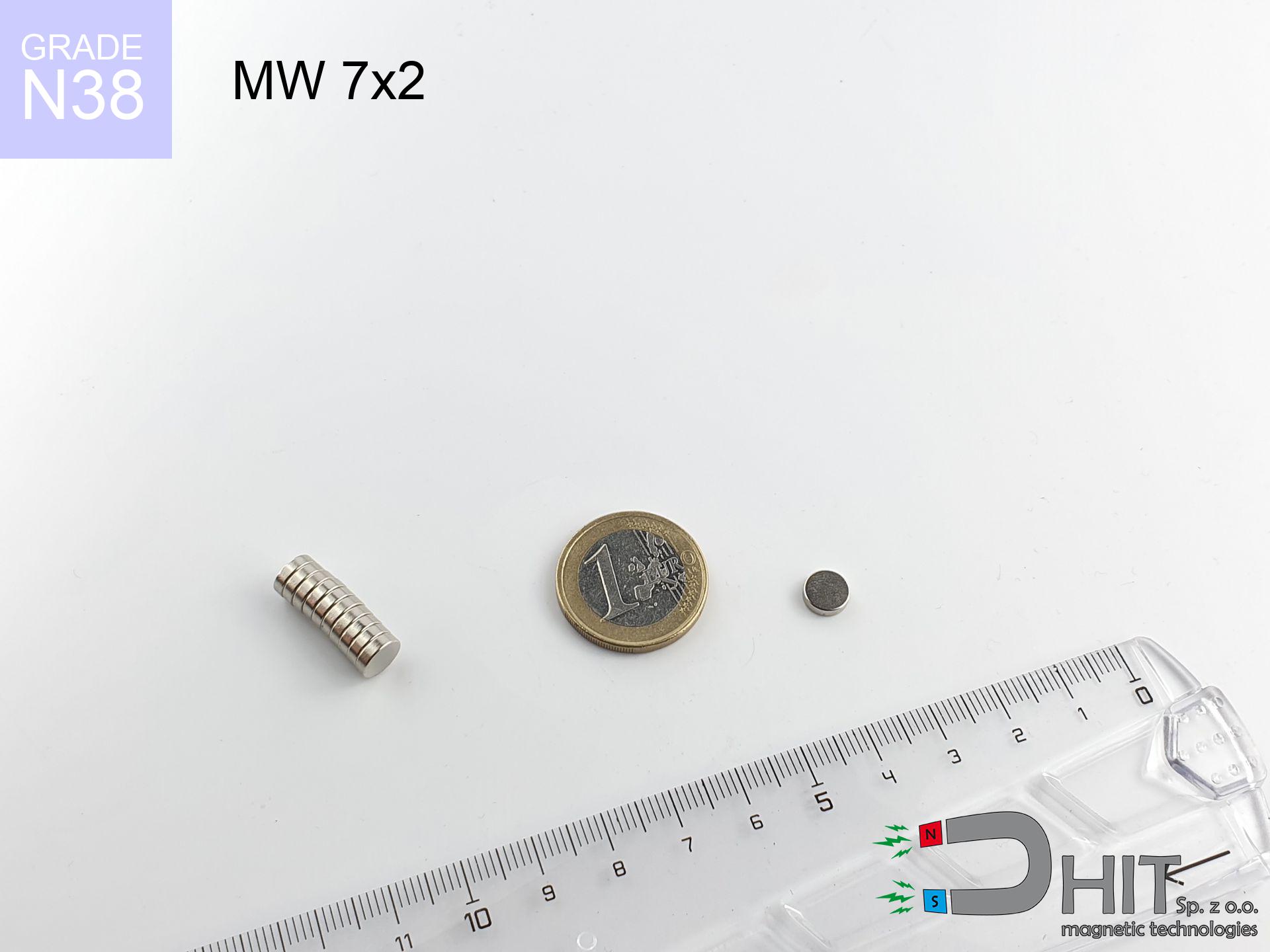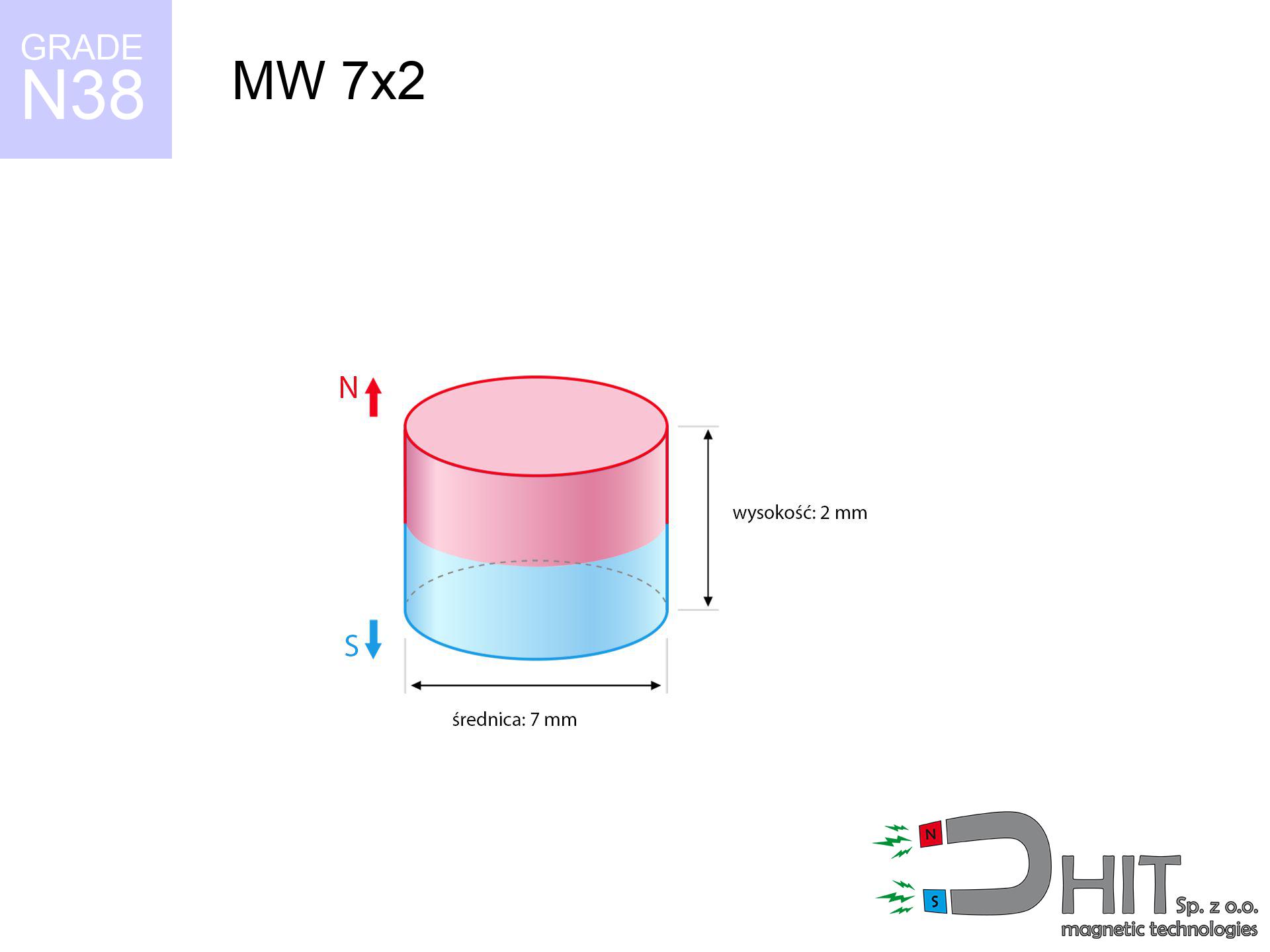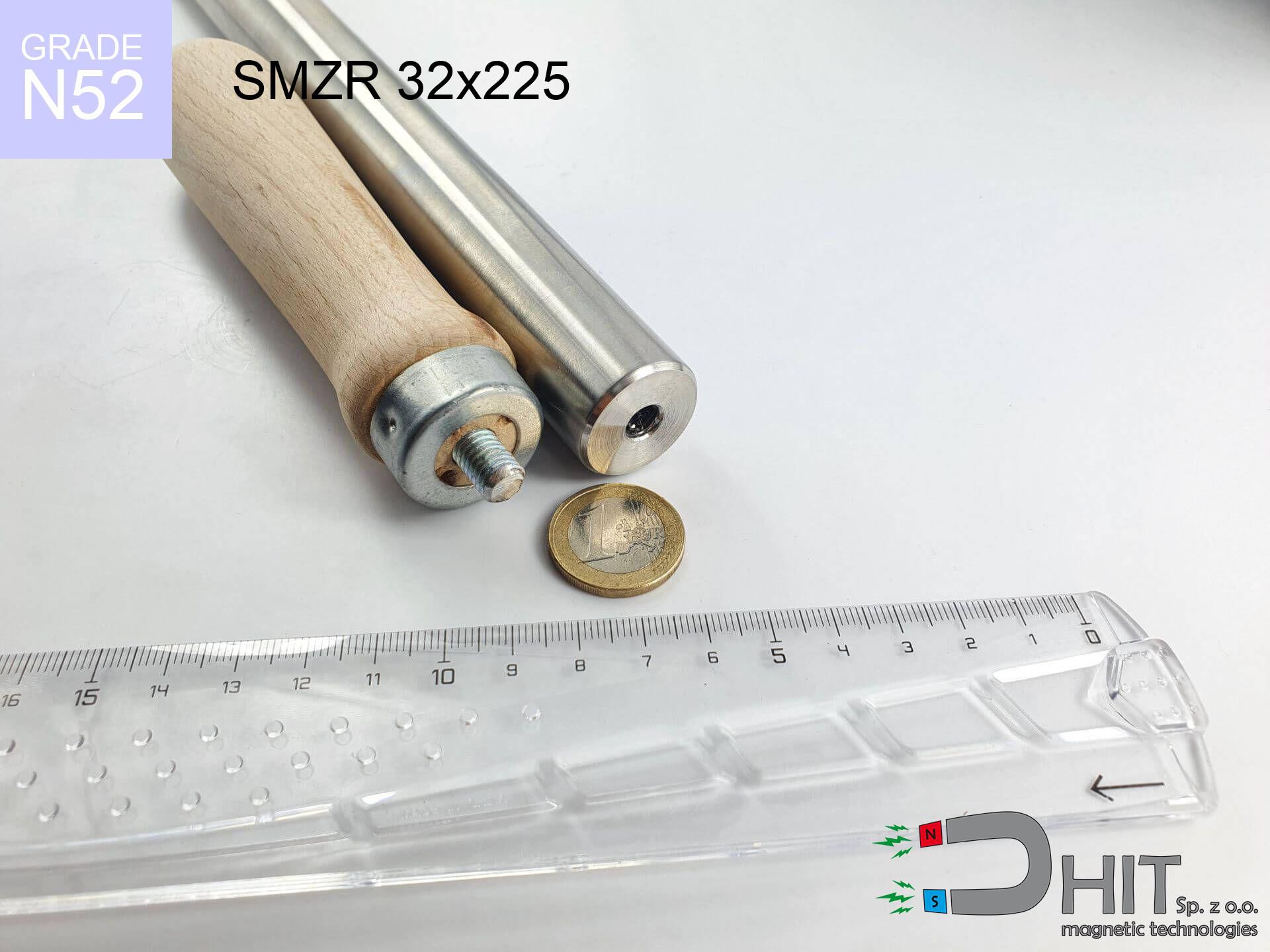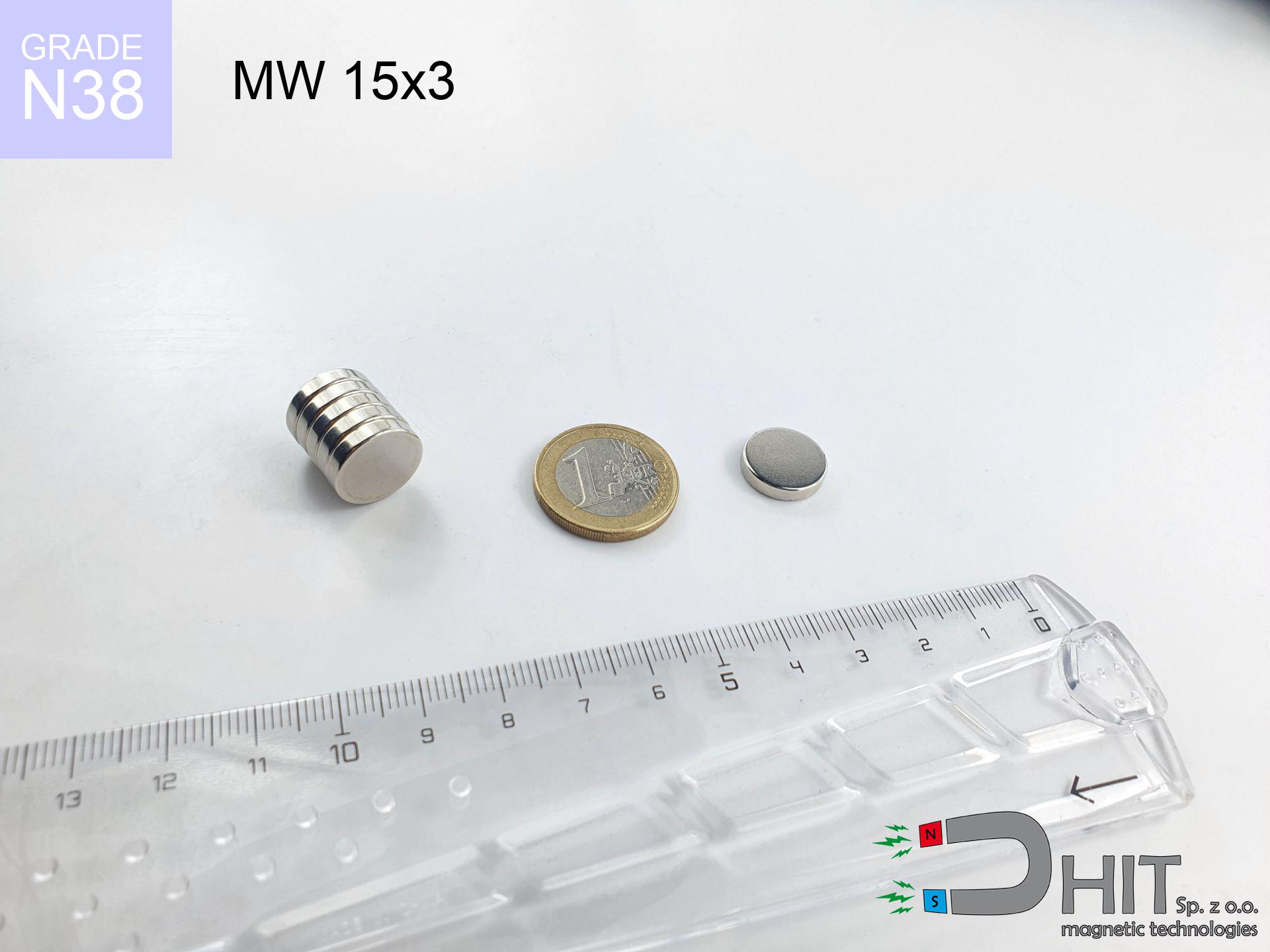MW 7x2 / N38 - cylindrical magnet
cylindrical magnet
Catalog no 010099
GTIN: 5906301810988
Diameter Ø [±0,1 mm]
7 mm
Height [±0,1 mm]
2 mm
Weight
0.58 g
Magnetization Direction
↑ axial
Load capacity
0.77 kg / 7.55 N
Magnetic Induction
307.23 mT
Coating
[NiCuNi] nickel
0.381 ZŁ with VAT / pcs + price for transport
0.310 ZŁ net + 23% VAT / pcs
bulk discounts:
Need more?Looking for a better price?
Call us now
+48 888 99 98 98
if you prefer contact us through
contact form
the contact page.
Parameters and appearance of magnetic components can be estimated on our
force calculator.
Orders submitted before 14:00 will be dispatched today!
MW 7x2 / N38 - cylindrical magnet
Magnetic properties of material N38
Physical properties of NdFeB
Shopping tips
Advantages as well as disadvantages of neodymium magnets NdFeB.
In addition to their magnetic efficiency, neodymium magnets provide the following advantages:
- They have unchanged lifting capacity, and over around ten years their performance decreases symbolically – ~1% (in testing),
- They protect against demagnetization induced by ambient electromagnetic environments very well,
- The use of a decorative silver surface provides a refined finish,
- The outer field strength of the magnet shows elevated magnetic properties,
- They are suitable for high-temperature applications, operating effectively at 230°C+ due to advanced heat resistance and form-specific properties,
- The ability for precise shaping or customization to specific needs – neodymium magnets can be manufactured in many forms and dimensions, which extends the scope of their use cases,
- Key role in cutting-edge sectors – they are utilized in hard drives, electric motors, diagnostic apparatus along with other advanced devices,
- Relatively small size with high magnetic force – neodymium magnets offer strong power in compact dimensions, which makes them useful in miniature devices
Disadvantages of NdFeB magnets:
- They can break when subjected to a powerful impact. If the magnets are exposed to physical collisions, we recommend in a protective enclosure. The steel housing, in the form of a holder, protects the magnet from fracture , and at the same time increases its overall resistance,
- They lose strength at increased temperatures. Most neodymium magnets experience permanent degradation in strength when heated above 80°C (depending on the geometry and height). However, we offer special variants with high temperature resistance that can operate up to 230°C or higher,
- Magnets exposed to wet conditions can corrode. Therefore, for outdoor applications, it's best to use waterproof types made of rubber,
- The use of a protective casing or external holder is recommended, since machining fine details in neodymium magnets is restricted,
- Safety concern linked to microscopic shards may arise, especially if swallowed, which is notable in the context of child safety. Additionally, minuscule fragments from these products can interfere with diagnostics if inside the body,
- Higher purchase price is an important factor to consider compared to ceramic magnets, especially in budget-sensitive applications
Maximum holding power of the magnet – what affects it?
The given holding capacity of the magnet corresponds to the highest holding force, calculated under optimal conditions, specifically:
- using a steel plate with low carbon content, serving as a magnetic circuit closure
- having a thickness of no less than 10 millimeters
- with a refined outer layer
- with no separation
- under perpendicular detachment force
- under standard ambient temperature
Key elements affecting lifting force
In practice, the holding capacity of a magnet is affected by these factors, from crucial to less important:
- Air gap between the magnet and the plate, since even a very small distance (e.g. 0.5 mm) can cause a drop in lifting force of up to 50%.
- Direction of applied force, because the maximum lifting capacity is achieved under perpendicular application. The force required to slide the magnet along the plate is usually several times lower.
- Thickness of the plate, as a plate that is too thin causes part of the magnetic flux not to be used and to remain wasted in the air.
- Material of the plate, because higher carbon content lowers holding force, while higher iron content increases it. The best choice is steel with high magnetic permeability and high saturation induction.
- Surface of the plate, because the more smooth and polished it is, the better the contact and consequently the greater the magnetic saturation.
- Operating temperature, since all permanent magnets have a negative temperature coefficient. This means that at high temperatures they are weaker, while at sub-zero temperatures they become slightly stronger.
* Lifting capacity was measured by applying a smooth steel plate of suitable thickness (min. 20 mm), under perpendicular pulling force, in contrast under attempts to slide the magnet the lifting capacity is smaller. Additionally, even a small distance {between} the magnet and the plate decreases the lifting capacity.
Exercise Caution with Neodymium Magnets
Do not place neodymium magnets near a computer HDD, TV, and wallet.
Neodymium magnets generate intense magnetic fields that can damage magnetic media such as floppy disks, video tapes, HDDs, credit cards, magnetic ID cards, cassette tapes, etc. devices. They can also destroy videos, televisions, CRT computer monitors. Do not forget to keep neodymium magnets away from these electronic devices.
The magnet coating is made of nickel, so be cautious if you have an allergy.
Studies clearly indicate a small percentage of people who suffer from metal allergies such as nickel. An allergic reaction often manifests as skin redness and rash. If you have a nickel allergy, you can try wearing gloves or simply avoid direct contact with nickel-plated neodymium magnets.
Neodymium magnets are characterized by their fragility, which can cause them to become damaged.
Neodymium magnetic are fragile and will break if allowed to collide with each other, even from a distance of a few centimeters. They are coated with a shiny nickel plating similar to steel, but they are not as hard. At the moment of connection between the magnets, small sharp metal pieces can be propelled in various directions at high speed. Eye protection is recommended.
It is crucial not to allow the magnets to pinch together uncontrollably or place your fingers in their path as they attract to each other.
Magnets will jump and also clash together within a distance of several to almost 10 cm from each other.
People with pacemakers are advised to avoid neodymium magnets.
Neodymium magnets generate very strong magnetic fields that can interfere with the operation of a pacemaker. This happens because such devices have a function to deactivate them in a magnetic field.
Never bring neodymium magnets close to a phone and GPS.
Neodymium magnets are a source of strong magnetic fields that cause interference with magnetometers and compasses used in navigation, as well as internal compasses of smartphones and GPS devices.
Neodymium magnets can become demagnetized at high temperatures.
In certain circumstances, Neodymium magnets may experience demagnetization when subjected to high temperatures.
It is essential to maintain neodymium magnets away from youngest children.
Remember that neodymium magnets are not toys. Do not allow children to play with them. They can be a significant choking hazard. If multiple magnets are swallowed, they can attract to each other through the intestinal walls, causing significant injuries, and even death.
Neodymium magnets are over 10 times stronger than ferrite magnets (the ones in speakers), and their strength can shock you.
On our website, you can find information on how to use neodymium magnets. This will help you avoid injuries and prevent damage to the magnets.
Dust and powder from neodymium magnets are flammable.
Do not attempt to drill into neodymium magnets. Mechanical processing is also not recommended. If the magnet is crushed into fine powder or dust, it becomes highly flammable.
Safety rules!
To raise awareness of why neodymium magnets are so dangerous, read the article titled How very dangerous are very strong neodymium magnets?.





![HH 42x8.8 [M6] / N38 - through hole magnetic holder HH 42x8.8 [M6] / N38 - through hole magnetic holder](https://cdn3.dhit.pl/graphics/products/hh-42x8.8-m6-hin.jpg)
![SM 25x150 [2xM8] / N42 - magnetic separator SM 25x150 [2xM8] / N42 - magnetic separator](https://cdn3.dhit.pl/graphics/products/sm-25x150-2xm8-cim.jpg)


